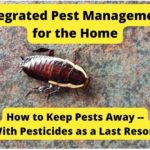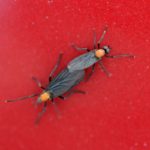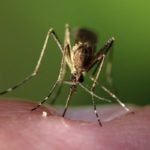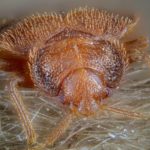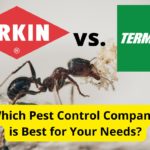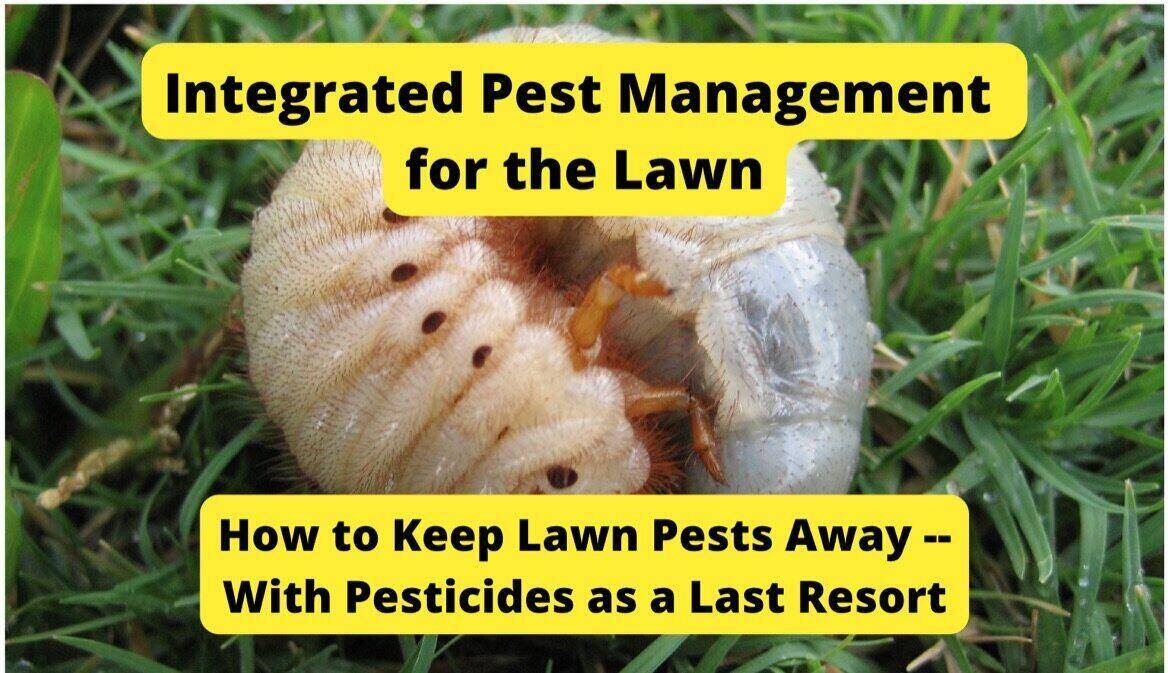
Pesticides are convenient, fast-acting lawn pest management tools, but are not a long-term solution. For pest control that keeps the grubs and chinch bugs away for good, try Integrated Pest Management (IPM) for your lawn.
IPM removes pest attractions like food, water, and shelter, taking your lawn off pests radar. It also keeps the grass healthy and more resilient to stress and damage. You’ll rarely need to use pesticides. Read our guide and learn how to apply IPM on your lawn to end pest infestations safely and effectively.
What is Integrated Pest Management?
Integrated Pest Management (IPM) is a pest control approach that minimizes pesticide use to protect the health and safety of people, pets, wildlife, and the environment. IPM uses strategies such as removing a pest’s food and water sources and strengthening your grass so it’s less susceptible to pest damage in the first place.
You can use pesticides in an IPM program, but only in the safest, most environmentally responsible way possible and as a last resort after trying other IPM components such as:
- Cultural practices
- Habitat manipulation
- Mechanical control
- Biological control
What is a lawn pest? A pest is any animal or plant harmful to people or human interests (such as destruction of property). That’s right — even the weeds in your turf are lawn pests.
Five Steps of Integrated Pest Management for the Lawn
Implementing IPM on your lawn is not a set-it-and-forget-it kind of thing. It’s a continuous, long-term process the homeowner leads, and their dedication is key to success. To benefit from IPM results, follow these five steps of Integrated Pest Management on your lawn:
Step 1: Set Up a Monitoring System
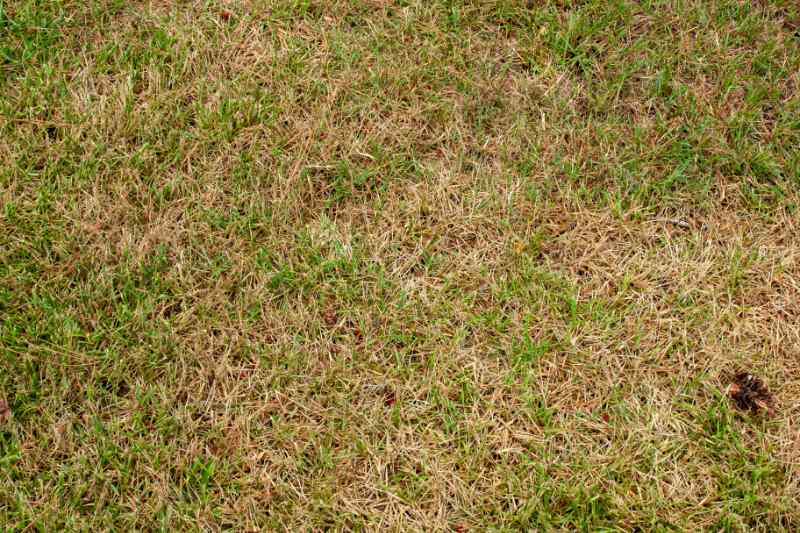
IPM strategies work on your lawn the best when you catch the culprit early on. Start by setting up an easy-to-follow monitoring routine to help you keep an eye on your lawn.
Check your lawn’s look and health thoroughly once a week. You can pair it with the weekly lawn irrigation to make it easier to remember. Check the grass more often if you start seeing damage.
Keep an IPM journal with what you notice on your lawn:
- Yellow grass
- Brown patches
- Bare spots
- Unusual colors in your grass (fungal diseases can turn your grass pink, grey, or neon green)
- A spongy feeling under your feet when walking on the lawn
- Holes in grass leaves and chewed-off spots
- Feet tracks are recovering slower than usual
Take a magnifying glass with you. It helps identify fungal infections and nasty lawn bugs more easily.
Pay extra attention to shaded areas, low spots, and turf areas near driveways and walkways.
The second role of monitoring is to evaluate your pest control methods once applied. Monitor the turfgrass before, during, and after an IPM intervention to find out if the technique works, how well and if you need to adjust it or replace it with more aggressive pest control methods.
Step 2: Identify Pest Problems
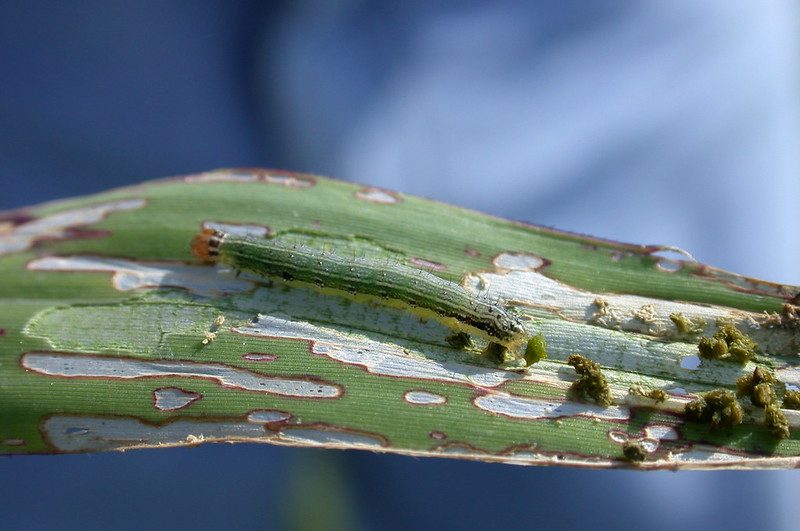
Lawn monitoring pays off, and you notice signs of turf stress. What do you do? Before deciding if it is a pest, exclude other causes that can lead to brown and dead patches. Sprinkler system problems and incorrect fertilization or herbicide use often cause brown spots.
Next, consider the season and the specific pests your lawn might face during that time. Here’s a short list of the active period of common lawn pests:
| Lawn Pests | Damage Period |
| Armyworms | April to May and August to October |
| Billbugs | July to August |
| Cutworms | April to October |
| Chinch bugs | April to August |
| Sod webworms | June to October |
| White grubs | June to October |
Look for the lawn bugs that could be active in your lawn and specific damage to narrow down the list and identify your target pest. There are two ways to check for lawn bugs: the drench test and inspecting your turfgrass roots.
Use the drench test to check for armyworms, cutworms, sod webworms, and chinch bugs:
- Mix 2 to 4 tbsp of liquid dish soap to 1 gallon of water.
- Apply the soap solution uniformly across an area that’s 3 feet by 3 feet.
- Include healthy and damaged grass in your test area.
- During the next 10 minutes, pests will rise to the surface. Identify the pests and get an average count per square foot.
Inspect the grass plant root zone to check for grubs and billbug larvae. Here’s how to do it:
- Dig or cut beneath the thatch layer in your lawn.
- Examine grass roots and crowns looking for larvae.
- Check an area of about 1 square foot. Collect any larvae you find in a can or a plastic bag so you can count them and check with your action threshold.
Step 3: Know Your Action Threshold
A few pests feeding on your lawn are common and nothing to worry about. Their presence becomes problematic when the pest population increases and their feeding habits exceed your turf’s tolerance level. At this point – called the action threshold – the damage is too severe for the grass to handle, and you must intervene with pest control methods.
Here are a few threshold examples for the most common lawn bugs:
| Lawn Pest | Action Threshold (Number of pests per square foot) |
| Armyworms | 3 to 5 |
| Billbugs | 20 to 25 |
| Cutworms | 1 |
| Chinch bugs | 15 to 20 |
| Sod webworm | 4 to 6 |
| White grubs | 8 to 10 |
Pro tip: Home lawns under stress from other causes are more susceptible to pests. In this case, you might need to act before the action threshold is met. Use the visible lawn damage to guide your IPM strategy.
Step 4: Use Pest Prevention Methods
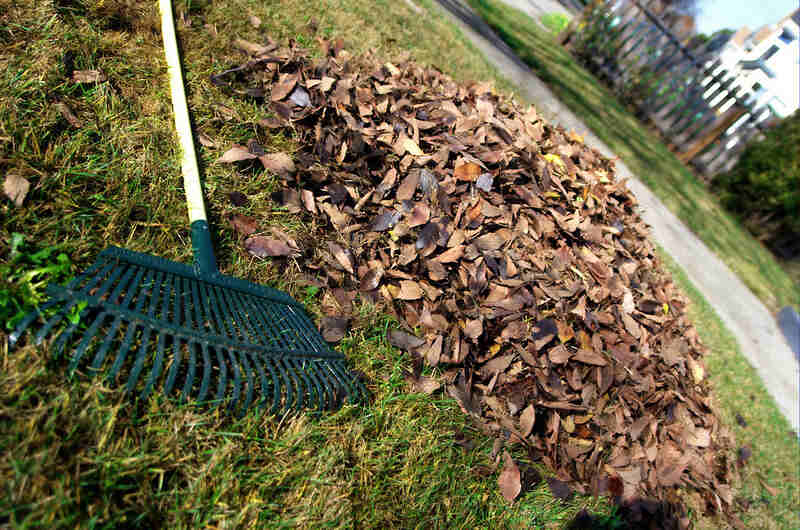
IPM focuses on lawn pest prevention rather than on killing the insects. Its purpose is to keep the lawn pest-free and avoid severe infestations. To achieve this, Integrated Pest Management for lawns focuses on proper lawn care and making the lawn less attractive to pests. Here are some ways:
- Planting pest-resistant turfgrasses
- Supporting natural enemies like ladybugs, lacewings, minute pirate bugs, and birds
- Keeping the grass healthy
- Avoiding excessive moisture
- Removing organic debris that can act as pest shelter or food
Step 5: Use Pest Control Methods
Once the action threshold has been met, you need to act. But how? Integrated Pest Management for lawns includes several pest control methods you can turn to, depending on the pest you’re dealing with and the severity of the infestation. We’ll talk about them in detail in the following section.
Integrated Pest Management Methods for Lawn Care
Integrated Pest Management includes various techniques to use on your lawn. Some techniques, like cultural practices and mechanical control, are mostly preventive and meant to discourage pest presence. They are the core of IPM programs. Others, like biological, and chemical control, are primarily corrective and can help you deal with active infestations.
The IPM pyramid shows how much of the Integrated Pest Management is actually prevention and relies on proper lawn maintenance and mechanical control.
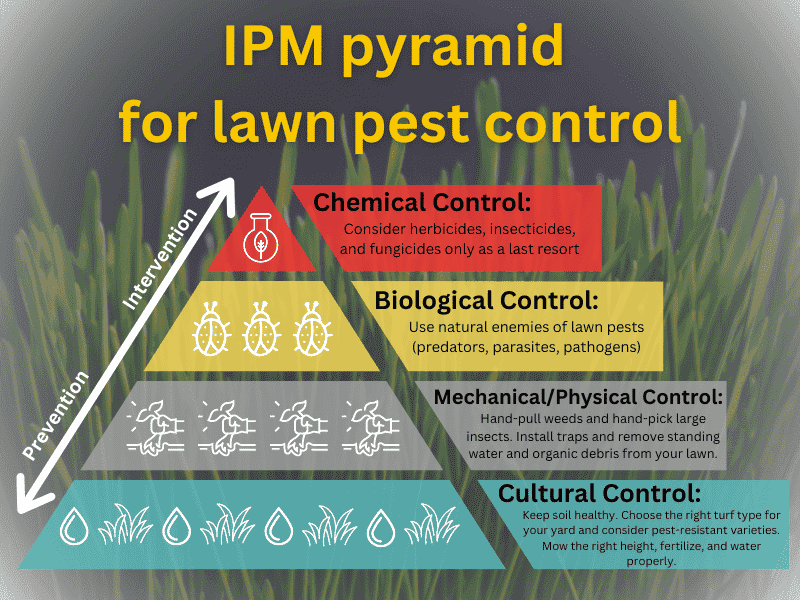
Cultural Practices
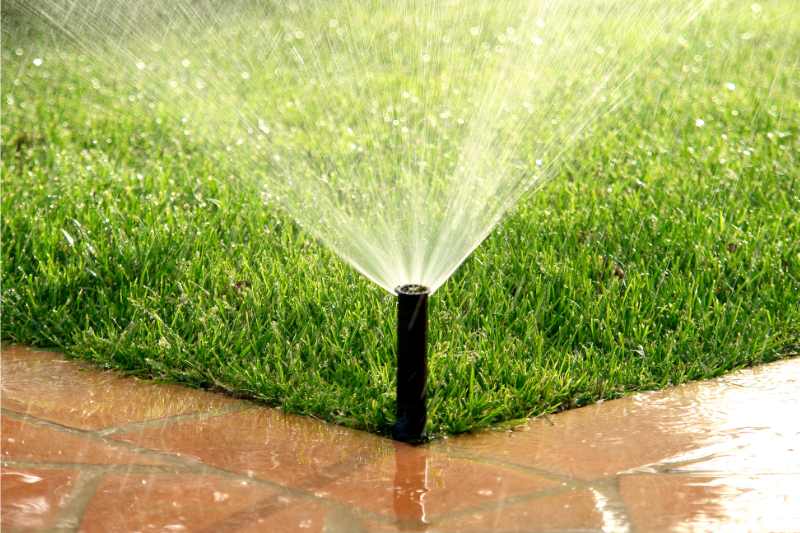
An effective IPM prevention tool is keeping the lawn healthy with good lawn care. Healthy turf that is properly watered, mowed, and fertilized is less attractive and vulnerable to pests. In ITM terms, we’re talking about cultural control measures. Here’s how they apply for your lawn.
Choose Suitable Grass Varieties
Choose a grass type that can thrive in your climate zone. In Northern states, plant cool-season grasses like Kentucky bluegrass, tall fescue, and ryegrass. Southern lawns suit warm-season grasses such as Bermudagrass, Zoysia, and St. Augustine.
Within each type, grass varieties differ by tolerance to salinity, drought, and shade. Different grass types also have different disease and pest resistance levels, water, and cultural needs. Choose the one that allows you to grow a hardy lawn with minimal intervention.
Water the Lawn Deeply and Less Often
Incorrect lawn irrigation is the most common cause of grass damage. Overwatering exposes grass to fungal infections and insect pests. It also promotes shallow roots, making the lawn more vulnerable to stress.
Here’s how to water your lawn the right way:
- Water in the morning between 6 a.m. and 10 a.m.
- Avoid evening irrigation. Water droplets cling to the grass blades at night and create a moist environment for pests and lawn diseases.
- Water once to twice a week. Aim to moisten the soil 6 to 8 inches deep each time to promote deep roots.
- Factor in rainfall to prevent overwatering. Most established lawns need 1 to 1.5 inches of water per week, including rainfall.
Fertilize When Needed
A lawn that receives proper nutrients grows healthy and sturdy. Healthy grass can handle some insect feeding and grass diseases without needing intervention. To fertilize the lawn correctly, follow these rules:
- Test the soil. Soil tests help you apply the right type and amount of fertilizers and soil amendments.
- Know your grass needs. Most turf types require 2 to 4 lbs. of nitrogen per 1,000 square feet yearly.
- Fertilize at the right time. Apply fertilizers during the growing season; otherwise, you’ll feed the weeds and expose your turf to fungal diseases and insect pests.
- Avoid nitrogen burns. Don’t apply more than 1 lb. of nitrogen per 1,000 square feet in one session.
- Use slow-release products. They are safer for your grass and the environment. Go for organic fertilizers as often as you can.
- Leave healthy grass clippings on the lawn (grasscycling) to provide natural nitrogen for your growing turf.
Mow the Lawn to the Proper Height
Proper mowing is an easy routine to keep the grass healthy and pests under control. Here’s how to mow your grass the right way:
- Follow the right mowing height for your grass species and season. You’d typically mow cool-season grasses 1.5 to 3 inches tall and warm-season grasses .75 to 1 inch tall.
- Use the one-third rule. Never cut more than one-third of the grass’s length at a time.
- Don’t mow a wet lawn. It opens up the blades to fungal infection.
- Keep the lawn mower blades sharp. Blunt blades slow down healing, exposing the grass to infection.
Aerate Compacted Soil
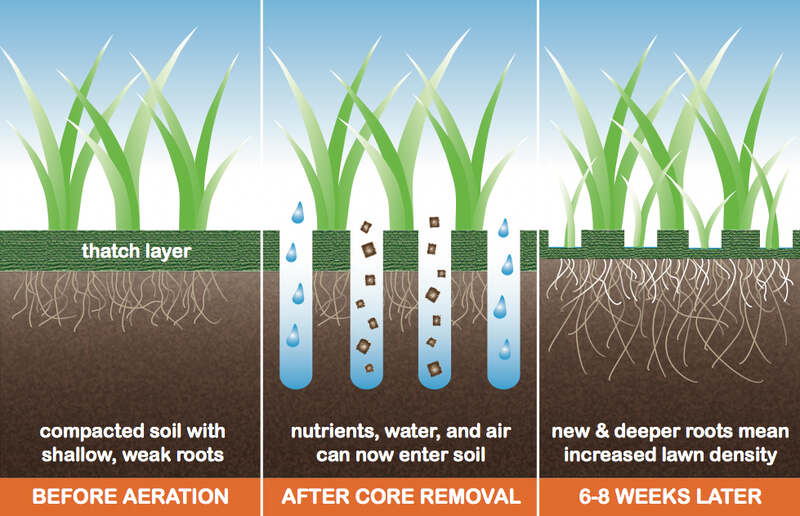
Core aeration relieves compaction by pulling up soil plugs from the ground. It loosens compacted soil and boosts your lawn’s health by giving the roots access to water, food, and oxygen. Aerate once a year with loamy soil and twice or more often if your lawn grows on clay soil.
Remove Thick Thatch
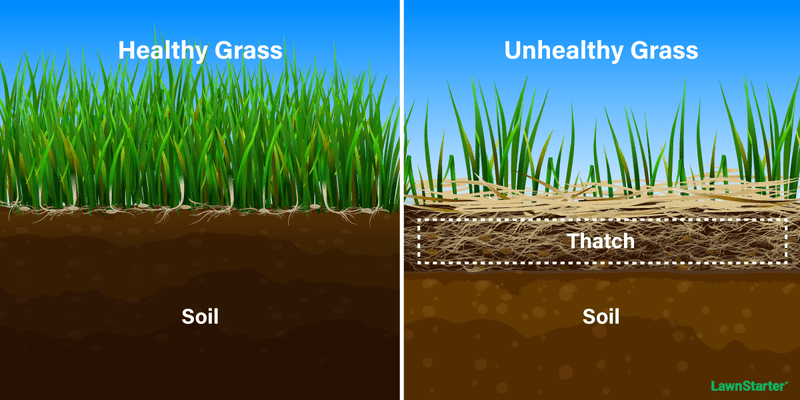
Thatch is a layer of dead organic matter that accumulates on the soil surface. A thin layer is good for your lawn, acting as mulch and food for helpful earthworms.
When over 1/2 inch thick, thick thatch is a health risk for your lawn:
- It limits airflow and keeps grass crowns and stems moist.
- It’s a delicious snack for insects like caterpillars and chinch bugs. Insects and fungi also use it as shelter.
- Pesticides can’t penetrate thick thatch to treat root-feeding pests properly.
Remove the thick thatch using a power rake, a verticutter, or a dethatcher.
To prevent thatch build-up in the first place:
- Avoid applying too much nitrogen
- Water deeply and less often
- Don’t use broad-spectrum pesticides. They kill the microorganisms that decompose thatch.
Overseed
Thick, healthy lawns are less vulnerable to weeds and deal more easily with pests. Even with a spotless season, some turfgrass will die, thinning your lawn, so make it a habit to overseed once a year.
Overseeding is also an excellent opportunity to:
- Replant brown patches and bare spots
- Mix more pest and disease-resistant varieties in your lawn
Fall is the best time to overseed cool-season grasses, and spring to early summer is the right period to spread seed on a warm-season lawn.
Keep Lawn Equipment Clean
Clean your lawn care tools carefully after each use. If you aerate or mow diseased turf, leave the infected areas last to avoid spreading the pest.
Habitat Manipulation
These IPM methods borrow pest control techniques from cultural control, mechanical control, and biological control. What brings them together is that you use them to make your lawn less attractive and accessible for grass insects and pathogens.
Grow Flowering Plants
Colorful flowers that produce pollen or nectar attract natural enemies of lawn pests like lady beetles and green lacewings. Plant them around your yard to support the predators you already have and attract some more. Supporting the native predators in your yard is more effective in the long term than buying and adding natural enemies.
Remove Debris
Your yard’s wood and brush piles provide an excellent snack bar and shelter for pests, including fungi, pest insects, rodents, and small animals. Make it a priority to get them off your lawn. Rake the autumn leaves and remove any organic matter that doesn’t belong on your turf.
Remove Water Sources
Standing water attracts pests to your lawn. It also provides a suitable environment for insects to multiply. Here are a few simple ways you can get rid of excess water and keep pests away:
- Clean dirty gutters. When gutters are clogged, they collect standing water.
- Remove empty flower pots and buckets from your yard.
- Empty and clean out birdbaths daily.
- Add a fountain or waterfall to your garden pond to keep the water moving – this wards off mosquitoes.
Build an Exclusion Barrier
Install exclusion barriers to keep pests out of your lawn. A 1-foot-tall fence buried about 10 inches in the ground can help keep gophers away. It also prevents voles, rabbits, and other rodents from entering your lawn.
Mechanical Control
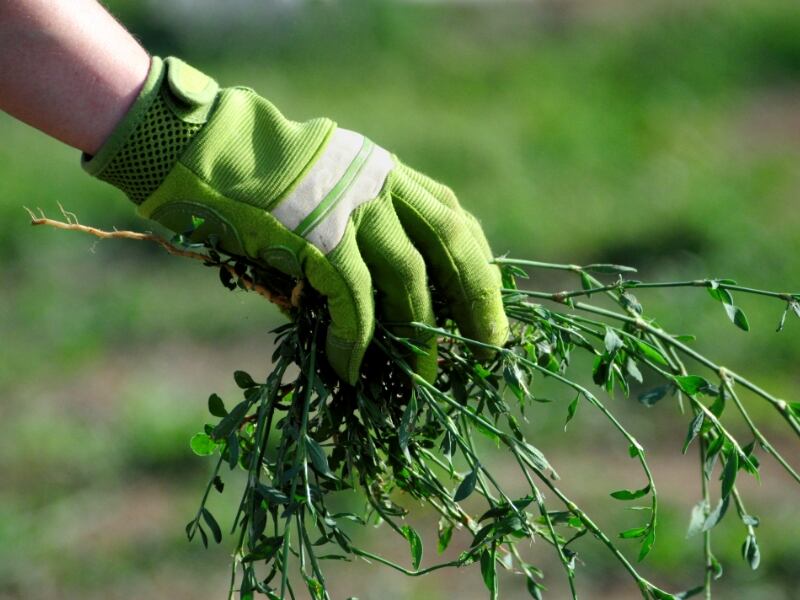
IPM mechanical methods refer to physically removing pests from your lawn, including:
Manual removal
Hand-pull weeds that are still in small numbers. Also known as hand weeding, this technique is highly effective on moist soil when all roots are pulled out.
When applied to insect pests, we call this technique handpicking. You can handpick large pests like grubs and cutworms from your lawn to reduce their population.
Traps
Install traps to catch larger pests like gophers and voles that are already on your lawn.
Other Mechanical Techniques
Your options vary depending on the pest you’re dealing with. A few examples include:
- Pouring hot water on fire ants
- Flooding gophers tunnels
- Mowing the lawn and collecting grass clippings to reduce fungal presence.
Biological Control
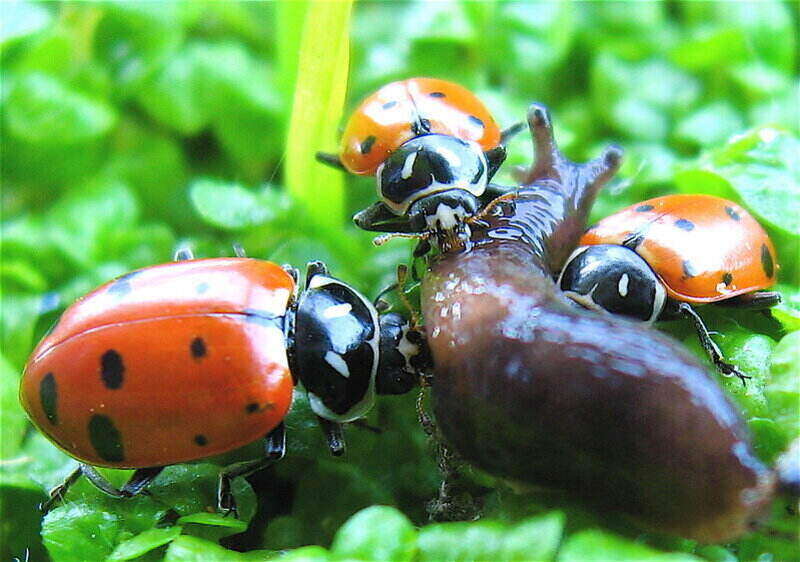
Before grabbing the pesticides, consider controlling the pest with a natural predator.
Beneficial Nematodes
Entomopathogenic nematodes are microscopic roundworms you can use against caterpillars and grubs. Each species of entomopathogenic nematodes is effective on certain types of lawn pests.
Microbial Insecticides
Microbial insecticides or biopesticides are safer for the environment and highly compatible with IPM lawn care programs. These products contain living pathogens like bacteria, fungi, protozoa, and viruses that infect and kill the pests. Two common examples include:
- Bacillus thuringiensis (Bt) is a microbe that kills pests in the early stages of their life cycles. It’s effective against mosquitoes, Japanese beetles, and other nasty lawn insects. The Bt strain you’ll want to use depends on the pest you’re trying to control.
- Milky spore is a bacterium that helps control Japanese beetle grubs.
Natural Predators
Predator insects, such as lady beetles, green lacewings, syrphid flies, ground beetles, aphid midges, soldier beetles, and spiders, eat some pests attacking your garden. You can encourage their presence by growing flowering plants around your yard.
If the native population can’t handle the pests, you can buy more ladybugs and lacewings online to add to your lawn’s protectors.
Birds also feed on your lawn pests. Installing bird feeders is an excellent way to attract them to your garden.
Parasites
Parasite insects use pests as hosts for their eggs. When their larvae hatch, they use the host as food, killing it. Two examples of beneficial insects acting as parasites are braconid wasps and tachinid flies. They control leaf-eating caterpillars and grasshoppers.
Chemical Control

The IPM approach considers the use of pesticides as a last resort, only to be deployed in severe lawn infestations where other IPM practices fail. IPM also recommends using products that are less harmful to the environment first, leaving synthetic pesticides for severe infestations that no other treatment can cure.
Types of IPM Pesticides
Here are the main categories of pesticides you can use on your lawn:
- Botanical pesticides contain toxins derived from plants or minerals. They are less harmful to the environment and are considered IPM-compatible pesticides. Three such examples are azadirachtin, Spinosad, and pyrethrins.
- Horticultural oils such as neem oil, citrus oil, or garlic oil also fit well in the IPM requirements.
- Insecticidal soaps are most effective on soft-body insects such as aphids and spider mites.
- Insect growth regulators (IGRs) mimic insect hormones and disturb reproduction.
- Synthetic chemicals are to be used as a last resort. A few broad-spectrum pesticides not IPM-compatible often applied on lawns are carbaryl, imidacloprid, clothianidin, and pyrethroids, the synthetic alternative to pyrethrins.
How to Apply Pesticides in IPM Programs
IPM safeguards the proper use of pesticides (when necessary) by following these basic rules:
- Treat your lawn with less aggressive IMP-compatible pesticides and turn to synthetic pesticides only when there is no other choice.
- Take your time to identify the turf pest and use a pesticide effective for its species.
- Apply selective pesticides instead of broad-spectrum pesticides. Selective pesticides kill the target pest without harming beneficial organisms (such as pollinators).
- Perform spot treatments where possible without risking reinfestation. Broadcast pesticide applications can harm beneficial insects and microorganisms.
- Use organic pesticides (usually more eco-friendly) instead of synthetic pesticides.
- Always read and follow the pesticide label instructions, even if you know the product. Mishandling pesticides can harm your family, pets, wildlife, and the environment.
FAQ About Integrated Pest Management
What are the Pros and Cons of IPM for Lawns?
IPM for lawn comes with pros and cons that every homeowner needs to consider.
The main pros of IPM are:
- Safer for the environment
- Maintains a balanced ecosystem
- Reduces pest control costs long-term
- Lower risk for pests to develop resistance to treatment
- Provides a long-term solution to pest control
The main cons of IPM are:
- It’s a trial-and-error method
- Most techniques must be applied more than once
- Requires extensive research and education
- It can be expensive short term
What are the Best Cultural Practices Within an IPM Strategy for Lawns?
The most effective cultural practices within an IPM strategy are:
- Growing the right type of grass for your yard
- Choosing pest and disease-resistant turfgrass
- Proper mowing, watering, and fertilization
What is the Most Effective Way to Implement IPM in a Residential Lawn?
The most effective way to implement IPM in a residential lawn is to start with healthy, strong turfgrass and correct lawn care practices. This might include reseeding damaged areas, overseeding with more resistant turf types, repairing sprinklers, and other improvements.
When to Hire a Pest Control or Lawn Care Pro
From cutting the grass to aerating the soil, IPM for the lawn can chip away the little free time you have. Hire a local lawn care professional who can make your IPM plan a walk in the park.
Is your lawn already battling an infestation? Don’t let pests ruin your weekend, either. Call in a pest control professional who can send those pests packing and get your lawn green and healthy again.
LawnStarter writer Jane Purnell contributed to this article
LawnStarter may earn revenue from connecting you to a pest control professional.
Main Photo Credit: Rob and Stephanie Levy / Flickr / CC BY 2.0 with text overlay
